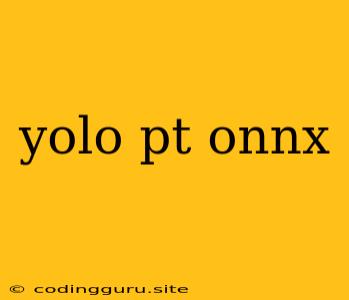YOLO: A Revolution in Object Detection
The world of computer vision has witnessed significant advancements in recent years, with object detection standing out as a pivotal area. Among the plethora of object detection algorithms, You Only Look Once (YOLO) has emerged as a true game-changer, known for its speed and accuracy.
YOLO, in its various iterations, has become a popular choice for real-time object detection applications. Its efficiency stems from its unique approach of processing the entire image at once, unlike traditional methods that rely on sliding windows. This single-pass processing allows YOLO to achieve impressive frame rates, making it suitable for tasks requiring rapid analysis.
Understanding ONNX: A Universal Language for Deep Learning Models
While YOLO offers remarkable performance, its implementation often involves specific frameworks. This can pose challenges when deploying models across different platforms or when integrating them into existing pipelines. Enter ONNX (Open Neural Network Exchange), an open standard that aims to bridge the gap between these frameworks.
ONNX provides a unified representation for deep learning models, enabling developers to export and import models between various frameworks without the need for complex code conversions. This interoperability is crucial for achieving seamless integration and promoting model sharing within the research community.
The Power of YOLO and ONNX: A Powerful Combination
The combination of YOLO's speed and accuracy with ONNX's interoperability opens up a wide range of possibilities for object detection tasks. This synergy empowers developers to leverage the strengths of both technologies, leading to faster development cycles, improved model portability, and greater flexibility in deployment.
Leveraging YOLO with ONNX: A Practical Guide
- Model Training: Train your YOLO model using your chosen framework (e.g., PyTorch, TensorFlow).
- Exporting to ONNX: Once the model is trained, export it to the ONNX format. This step typically involves using the respective framework's ONNX exporter.
- ONNX Runtime: Utilize ONNX Runtime, a high-performance inference engine, to execute your ONNX model. ONNX Runtime provides optimized execution for various hardware platforms, including CPUs, GPUs, and specialized hardware like TPUs.
- Deployment: Deploy your ONNX model on your desired platform. This can include cloud services, edge devices, or embedded systems.
Advantages of Using YOLO with ONNX:
- Portability: Easily move your YOLO model between different platforms and frameworks without significant code modifications.
- Optimization: Benefit from the performance enhancements offered by ONNX Runtime, especially for inference on resource-constrained devices.
- Interoperability: Promote model sharing and collaboration by utilizing the open standard format.
- Flexibility: Deploy your models in various environments with ease, adapting to specific requirements.
Conclusion:
The combination of YOLO and ONNX represents a powerful solution for object detection tasks, offering speed, accuracy, and interoperability. This synergistic approach empowers developers to build, deploy, and scale object detection models with greater efficiency and flexibility. The ability to easily move YOLO models across different platforms opens up exciting possibilities for a wide range of applications, from autonomous driving to medical imaging analysis. As deep learning continues to evolve, the synergy between YOLO and ONNX is likely to play a crucial role in shaping the future of computer vision.
